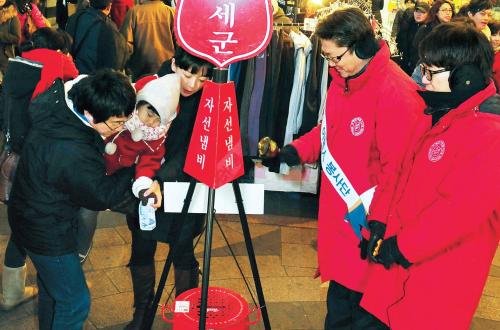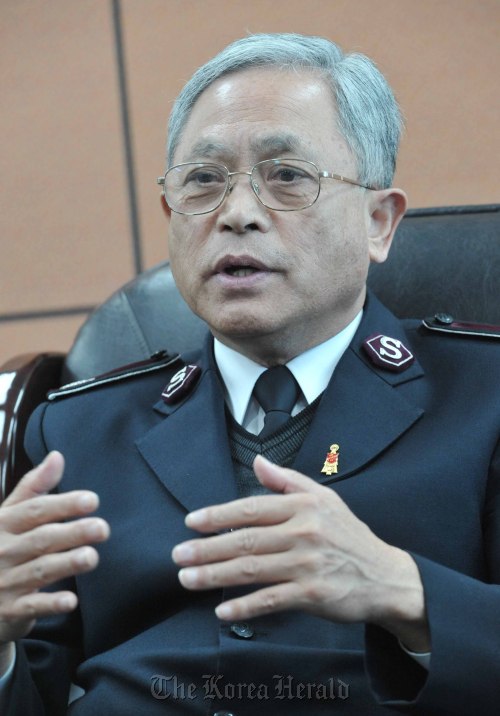
Salvation Army’s Red Kettle Campaign continues 83 years on
There are few surer signs that Christmas is upon us than when the familiar red kettles and bell chimes of the Salvation Army appear in the streets.
Now in its 83rd year, the Salvation Army’s annual Red Kettle Campaign has long been one of the easiest ways to participate in philanthropy. All it takes is to toss spare change into the red kettle while passing by or secretly leave a larger amount of cash or item for the less fortunate.
This year saw some generous donations.
On Wednesday, an elderly couple visited the Salvation Army headquarters in Seoul to give 200 million won ($172,000) in person. In 2009, they gave 100 million won to the Salvation Army. The reason they didn’t put the money in a kettle but brought it personally was to ask the Salvation Army to write them a thank you-letter. They intend to leave the letters to their children when they die.
“Instead of handing down a fortune to my children, I will give the letters to them,” said the 92-year-old man who asked to remain anonymous.
There are few surer signs that Christmas is upon us than when the familiar red kettles and bell chimes of the Salvation Army appear in the streets.
Now in its 83rd year, the Salvation Army’s annual Red Kettle Campaign has long been one of the easiest ways to participate in philanthropy. All it takes is to toss spare change into the red kettle while passing by or secretly leave a larger amount of cash or item for the less fortunate.
This year saw some generous donations.
On Wednesday, an elderly couple visited the Salvation Army headquarters in Seoul to give 200 million won ($172,000) in person. In 2009, they gave 100 million won to the Salvation Army. The reason they didn’t put the money in a kettle but brought it personally was to ask the Salvation Army to write them a thank you-letter. They intend to leave the letters to their children when they die.
“Instead of handing down a fortune to my children, I will give the letters to them,” said the 92-year-old man who asked to remain anonymous.

Early this month in Myeongdong, one of the most bustling spots in central Seoul, bell ringers found a 110 million won ($95,000) check, the largest amount put in a red kettle since the campaign started in 1928. The anonymous man believed to be in his 60s wrote a note along with the huge sum: “Meager as this amount may be, I hope it will be used to help the sick and lonely old people.”
Bell ringers have also found some unusual items this year, including false dentures, blood donor cards, transportation cards and gift certificates, according to the Salvation Army website. They have also received piggy banks full of coins and a gold ring to celebrate a child’s first birthday.
Kim Taek-bien, a Salvation Army officer, recalled an unusual scene a few years ago.
“A couple who were fighting in front of the red kettle took off their rings and put them into the kettle. Asked why, they said they believed they should do something good when they broke up.”
The red kettle campaign is not limited to the streets. Red kettles can be also seen at schools and kindergartens. The Salvation Army goes wherever people are likely to be.
The campaign started in Myeongdong in 1928 to offer hot meals to the homeless. Donations to the campaign increased each year from 848 won in the first red kettle 83 years ago to 4.2 billion won last year, carrying on the original spirit of 1891 when the red kettle campaign was first launched in San Francisco in U.S. to provide Christmas meals to the poor.
In Korea, the campaign relies on more than 30,000 volunteers and Army officers, and aims to collect 4.5 billion won this year to help more than 1.5 million people in need of food, clothing and other basic necessities.
Despite the business downturn, the Army expects to reach its donation goal this year.
“Considering the recent generous donations, we are optimistic about meeting the goal,” said Hong Bog-sik, an Army officer.
The money to be collected from about 300 kettles scattered nationwide will be used to help those in need as well as fund Salvation Army programs throughout the year.
“The money will be used to support anyone who asks for help from the Salvation Army outside of our year-round program,” said Hong.
According to the officers, the Army draws up a plan on where to use donated money before starting the campaign and reports it to the Ministry of Public Administration. The donated money goes to the socially or economically underprivileged in Korea as planned, but when an unexpected disaster occurs, for example Japan’s earthquake and tsunami in March, part of it can be spent to help the victims.
The Army runs many charity programs all year round, although the red kettle campaign is the most iconic.
As a Protestant church, the Salvation Army started missionary work together with charity activities. It believed in helping those deprived of basic welfare before preaching the gospel to them.
The first charity work in Korea began at an orphanage for homeless children living in an underground tunnel in Myeongdong. It continued to grow and grow, and the Army built schools for them and shelters for single mothers and their children, founded social enterprises to help the mothers earn money and set up a rehab center for alcoholics and the homeless.
“Our work has been evolving incessantly, all the faster whenever we find the needs of the poor and underprivileged,” said Park Man-hee, a Korea territorial commander of the Salvation Army.
“What sets the Salvation Army apart from the others is that we don’t do what the government or social workers can do. We begin work that no one has ever tried.”
The Salvation Army Korean Territory has another responsibility, which goes beyond the country ― to North Korea and Mongolia.
As one of a few private organizations the Unification Ministry allows to visit the North, it has managed to help North Koreans whenever allowed by the fluctuating relations between the North and South.
It established a branch in Ulaanbaatar in 2008 on the 100th anniversary of the Salvation Army Korea Territory and opened a school for Mongolian students to attend after school. It also provides financial assistance for children to have heart surgery.
The campaign ends on Saturday. Still, the door for donations to the Salvation Army will be open until the end of January.
If you haven’t dropped change in the red kettle yet but would like to donate, you can through a money transfer to the Army bank account or over the phone. Visit http://salvationarmy.or.kr for details.
By Lee Woo-young (wylee@heraldcorp.com)
-
Articles by Korea Herald












![[Today’s K-pop] BTS pop-up event to come to Seoul](http://res.heraldm.com/phpwas/restmb_idxmake.php?idx=644&simg=/content/image/2024/04/17/20240417050734_0.jpg&u=)





![[KH Explains] Hyundai's full hybrid edge to pay off amid slow transition to pure EVs](http://res.heraldm.com/phpwas/restmb_idxmake.php?idx=652&simg=/content/image/2024/04/18/20240418050645_0.jpg&u=20240419100350)

![[Today’s K-pop] Zico drops snippet of collaboration with Jennie](http://res.heraldm.com/phpwas/restmb_idxmake.php?idx=642&simg=/content/image/2024/04/18/20240418050702_0.jpg&u=)